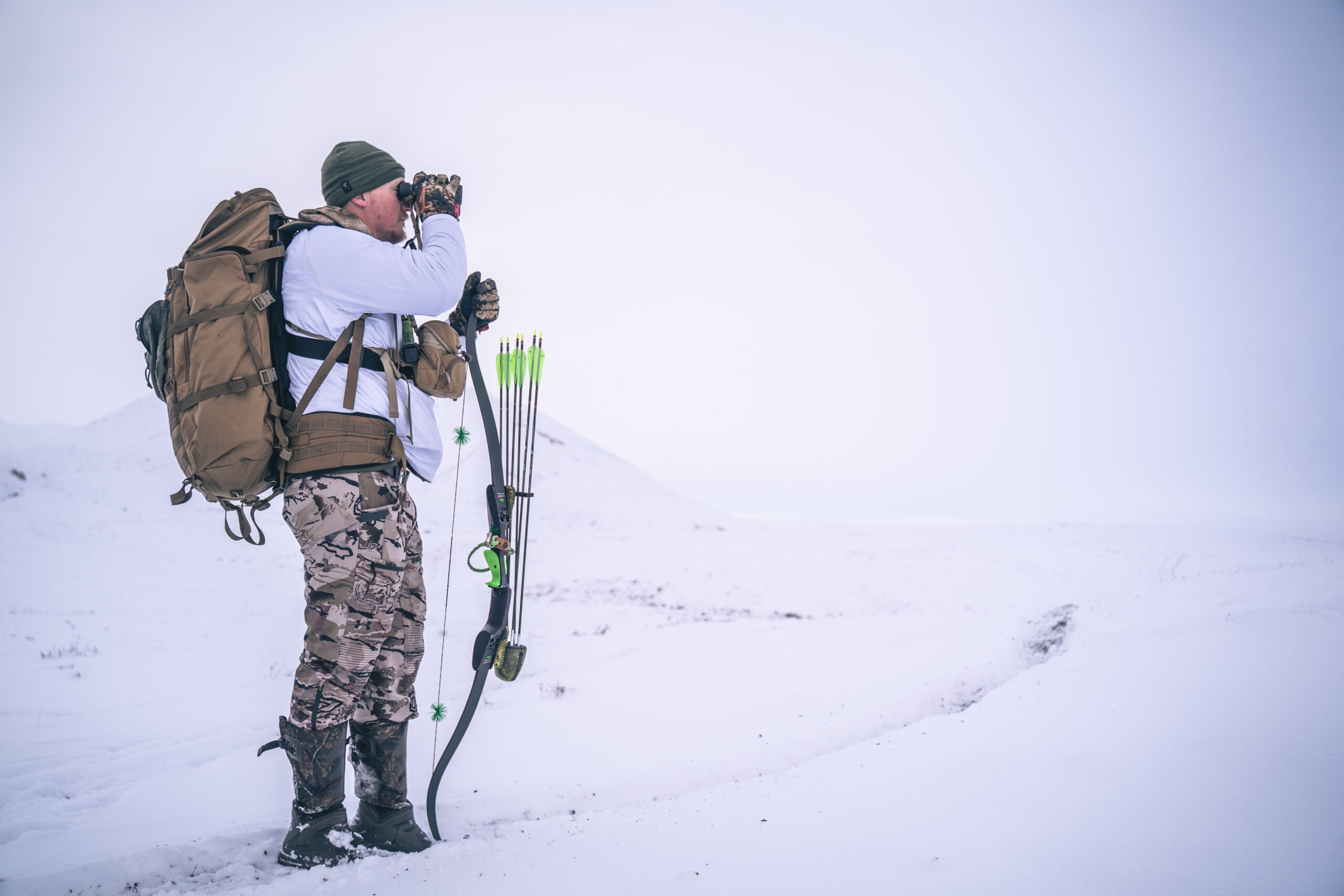We had to be getting close. I picked my way through the rocks along the edge of the half-frozen creek, knowing that any minute I would intersect trails beaten into the snow by thousands of caribou hooves. But could we make it in time? We couldn’t see the trails as we hurried alongside the steep cut bank, although I knew they had to be right here somewhere. I climbed up a few feet to peek over the bank, only to see a hundred caribou about 50 yards away. They saw me too. The stalk was blown.

The hundreds of caribou that we had tried to ambush were now moving away. Though we could hear the grunting, snorting, and occasional clash of antlers just over the hill, they might as well have been a mile away. They flowed like water over the tundra.
All we could do was look for another group of caribou to stalk. Luckily this shouldn’t be much of a problem, as thousands of caribou were migrating through this snowy stretch of rolling hills and wide valleys at the northern edge of the Brooks Range, within the largest bowhunting-only area on the continent.
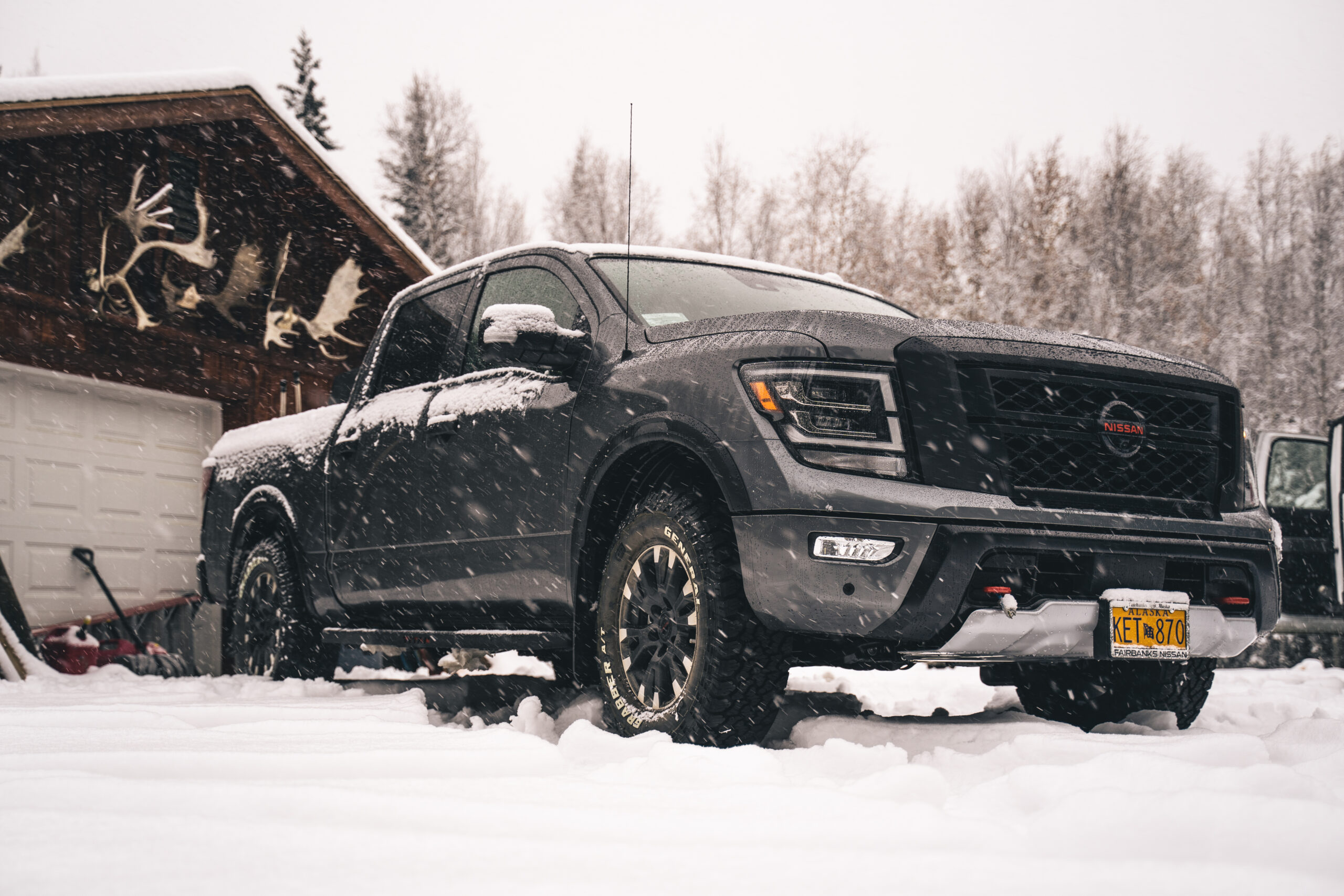
Hitting the Haul Road
The Dalton Highway, or “Haul Road” as it is commonly referred to, could be considered an irreconcilable dichotomy. It’s where ambitious industry and true wilderness meet—and coexist. The 414-mile industrial road was constructed in 1974 to facilitate building the Trans-Alaska Pipeline and service the new oilfields in Prudhoe Bay. It provides the vital link that allows oil to flow all the way to the Port of Valdez to this day.
Although its primary function is still to service the pipeline and oil fields, the Haul Road was opened to the public in 1980 and has provided and created access to millions of acres of public land. The Dalton Highway Corridor Management Area extends five miles on either side of the road and stretches about 370 miles from the Yukon River north to Prudhoe Bay, in which only bowhunting for big game is allowed.
“This is going to be a long drive,” I told my dad and our videographer Tanner Denton as we loaded up our gear with the snow still falling.
With about 500 miles to go and six inches of wet snow on the ground, we had a challenging drive ahead. The Haul Road is not only the most remote highway in the U.S., but it also has a reputation for tough driving conditions. It’s been featured on shows like Ice Road Truckers, and most rental vehicle contracts explicitly forbid driving on it. Even travel guides suggest bringing not one, but two new spare tires. For decades, the road was all gravel, and although some sections are now paved, much of the pavement is honestly worse than the gravel. On the drive, you’ll encounter huge potholes, frost heaves, rocks slung into your windshield from passing big rigs, and a unique silty sludge that will coat your entire vehicle. It was early October, and we knew that wet, muddy, and icy conditions were going to be a fact of life.
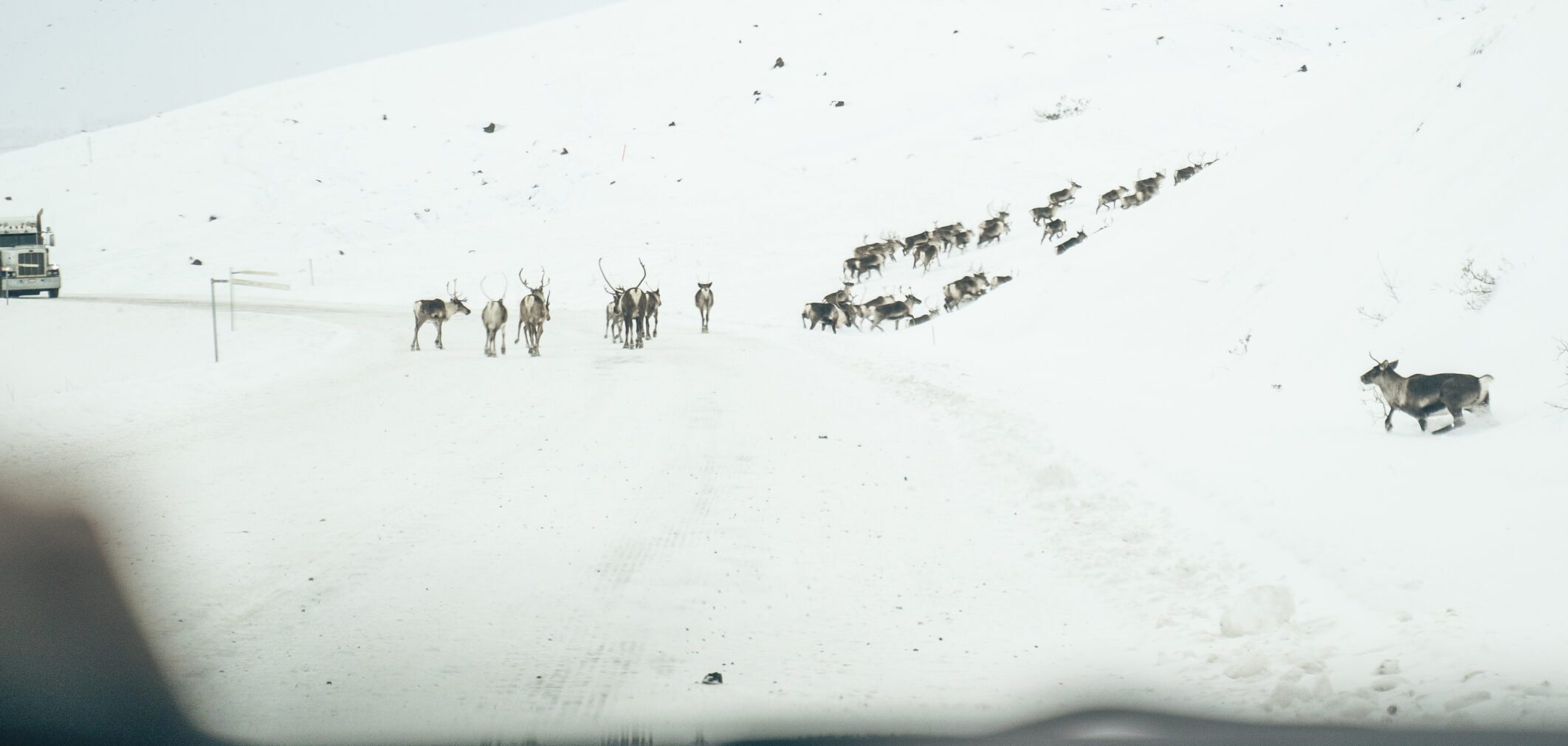
The Central Arctic Herd
Despite the relatively easy access, popularity, and long seasons, I hadn’t ever really given an honest effort to a Haul Road hunt. I’m usually distracted by sheep and moose hunting, and aside from sneaking away on days off while working in Prudhoe Bay a couple times, the last time I had made the drive was in 2009 with my dad. So it was fitting that Dad was coming along with me on this trip.
Even so, this was anything but a slam dunk. As migrators, caribou are where they are, and you find them when you find them.
We hit the road shortly after first light. By the time the sun began to set, we were looking at more than a thousand caribou scattered across the barren hillsides in the northern foothills of the Brooks Range. With the temperature dropping quickly, it was time to set up camp, string our bows, and heat the wood stove. As we discussed our plan for the following morning, we hoped that the caribou tracks that littered the fresh snow around our camp were a good sign. I had been told by folks who are much more experienced than I, that this time of year, the herds of caribou will overnight up in the hills, then begin moving down in mid-morning. It looked like we were in a good position.
The next morning, we began gearing up as the coffee percolator thumped on the small wood stove. We periodically peeked outside the tent, looking for any major movement in the herds of caribou.
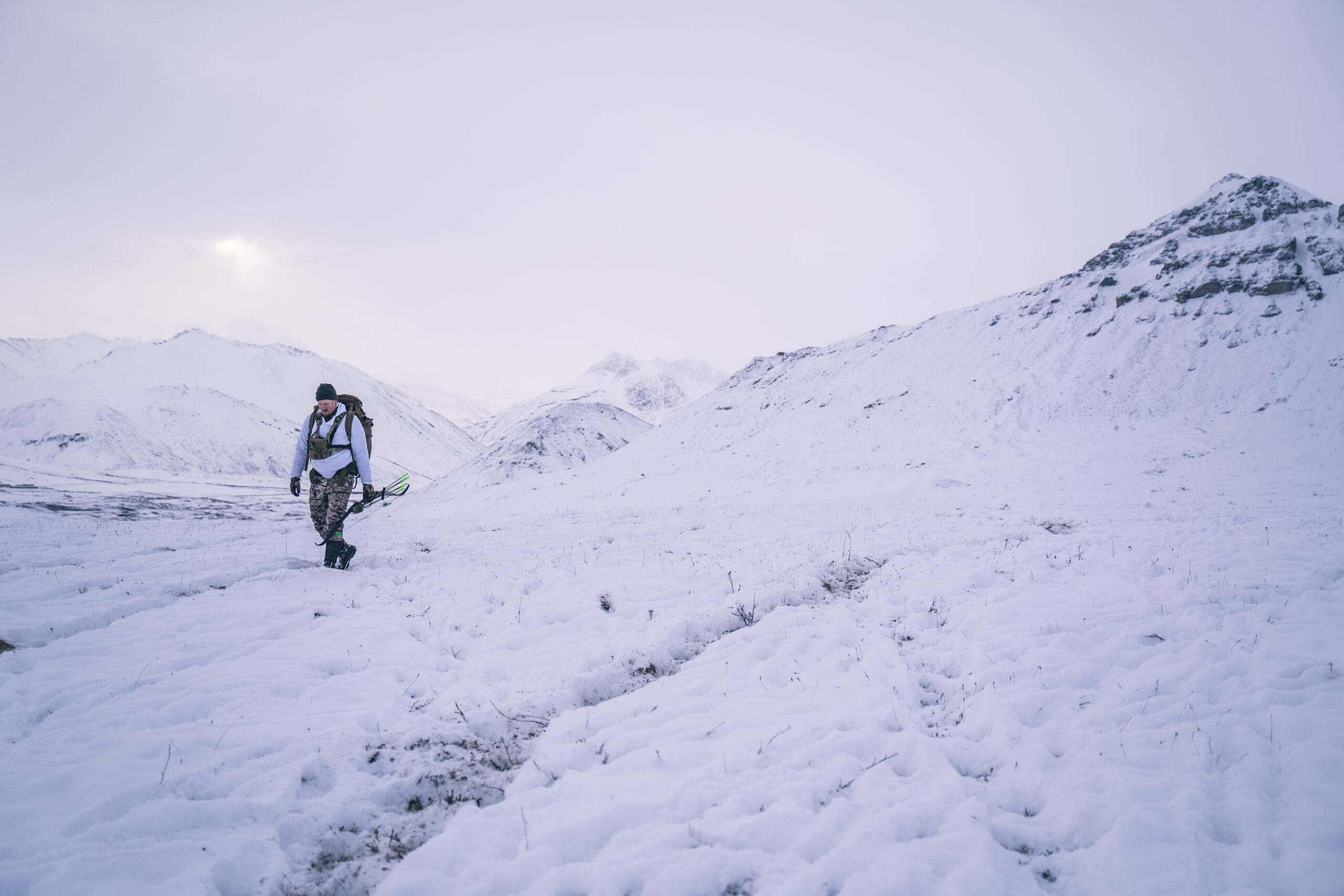
Our basic strategy was simple and dictated almost entirely by the terrain and the nature of the caribou. In herds of hundreds or more, on completely barren tundra, it would be all but impossible to sneak close enough for a shot with our recurves. When caribou did pass by terrain features that might allow a stalk, the herds were almost constantly moving. At a feeding, strolling pace, it would be impossible for us to keep up or gain ground on them to get into position. Instead, this hunt had to be an ambush. We had to take advantage of any terrain feature we could hide in, and let the caribou come to us.
“They’re pointed this direction,” I said as I stuck my head out of the tent. “I think we need to get moving.”
A herd of caribou was on its feet and moving on a low ridgeline about a mile away, angling for a ravine a few hundred yards from camp. Before we had much time to react, caribou began popping up onto the ridge on the other side of the creek, having already crossed. We had missed our opportunity.
“I think they’re going to drop down to the bottom eventually, so let’s work around and try to find a way to get in front of them,” I said.
We quickly hooked to our left, just above the base of the hills that the herd was moving along. They didn’t seem to be in a hurry. I don’t often think of caribou as an especially vocal animal, so it’s always surprising to hear their bellowing and snorting. As we crested the top of the hill which had been covered in caribou minutes earlier, we saw the last animals of the herd cresting over another skyline, headed farther back into the mountains. The barnyard-like scent of caribou hung in the air as we walked back.
Close Calls
When I saw the trails converge into one spot crossing the ravine above camp, I knew that this place had everything we needed for an ambush. The caribou had to cross a hilltop, then drop down a tall, steep bank, then cross two different channels before climbing out on a single trail that exited the other side. We would be able to see the next herd coming from camp, then quickly move into position to intercept them.
Back at camp, the percolator hadn’t even started boiling when another herd came over the far ridgeline, headed right for that creek. We threw on our backpacks and grabbed our bows, the herd moving closer with every precious second. The animals were coming from the north and I wanted to be on the south edge of the ravine. We would be able to hide and have plenty of time to see bulls coming and get ready. I didn’t cross the creek soon enough though, and it quickly turned to deep pools covered by unstable ice. Crossing now was too risky, so we continued moving upstream against the steep bank. Just as we had almost reached the trail that the caribou were headed toward, I looked over that cut bank and spooked the entire herd. It was so close. If we had been just one or two minutes earlier, the outcome might have been different.
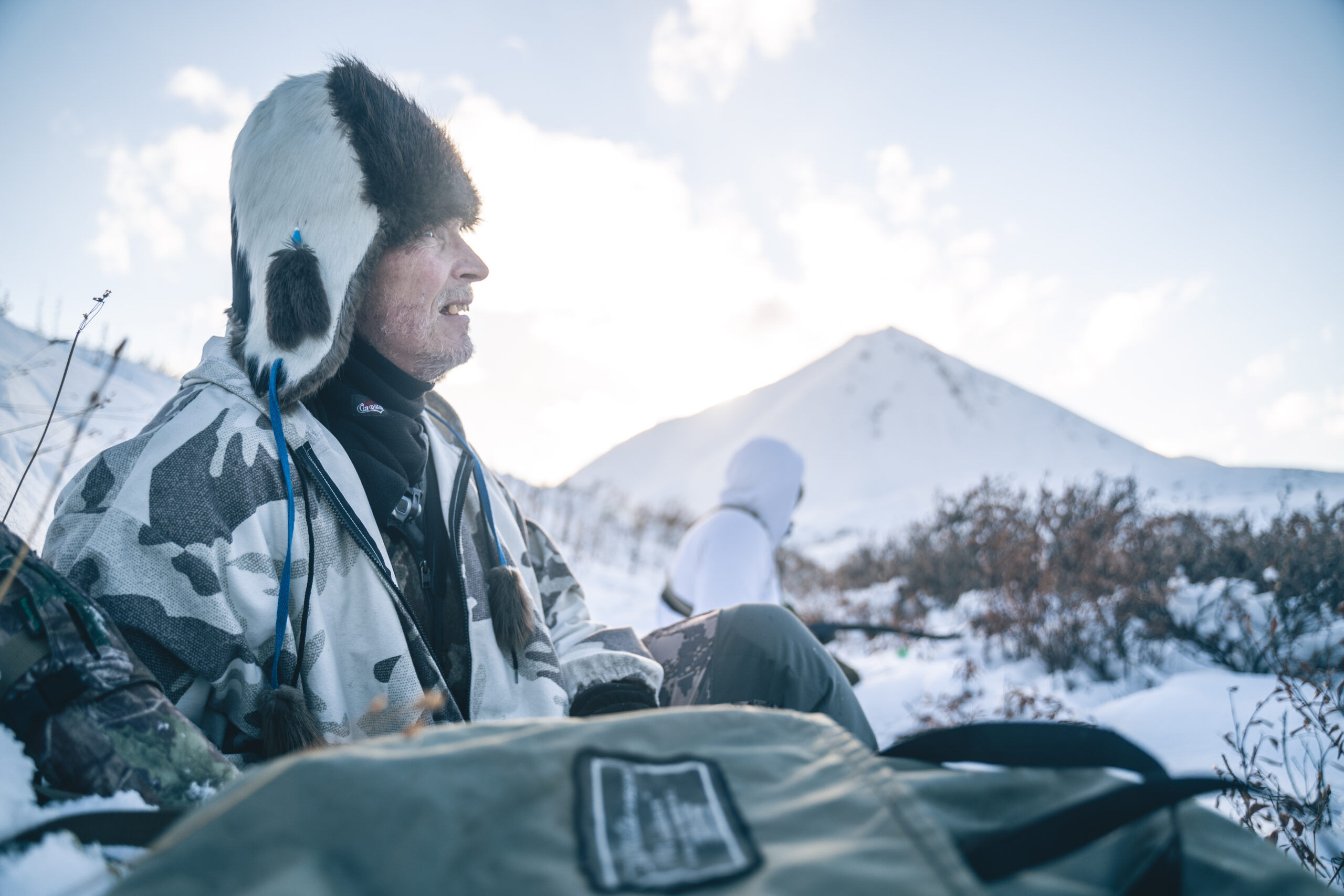
By that evening, the herds of caribou had abandoned their ridgetop route and began congregating in and moving through the valley below our camp. After rushing back and forth all day, we jumped in the truck and moved to a spot where we could see the entire valley. As evening began to fall, a big herd that had spent the day in the relative safety of the wide-open and flat valley began to move. Like spilled water trickling off a tabletop, a stream of caribou began to pull from the immense herd. In minutes, the line of caribou stretched as far as we could see into the mountains, crossing the creek just downhill of our camp. We tried one last time to slip into a gap in the herd, but that didn’t work either.
Pay Dirt
The next morning, we made the short drive from camp to where the road crested a nearby hill, giving us a good vantage of the whole valley. We could see hundreds (if not thousands) of caribou scattered across the foothills in the distance. They were beginning to move down to the valley floor. One cow would make the decision to go, followed by a single-file line of animals until the whole herd vanished. It was apparent that the whole mess of them was going to cross the road in a spot with virtually no cover and a howling 20 mph wind. To complicate matters, two other truckloads of hunters who were camped nearby were already positioning to try and have a crack at the approaching herd. We decided to wait where we were.
It was possible that some caribou could cross the creek we had been hunting, either above or below camp—we just needed to know which way they’d go.
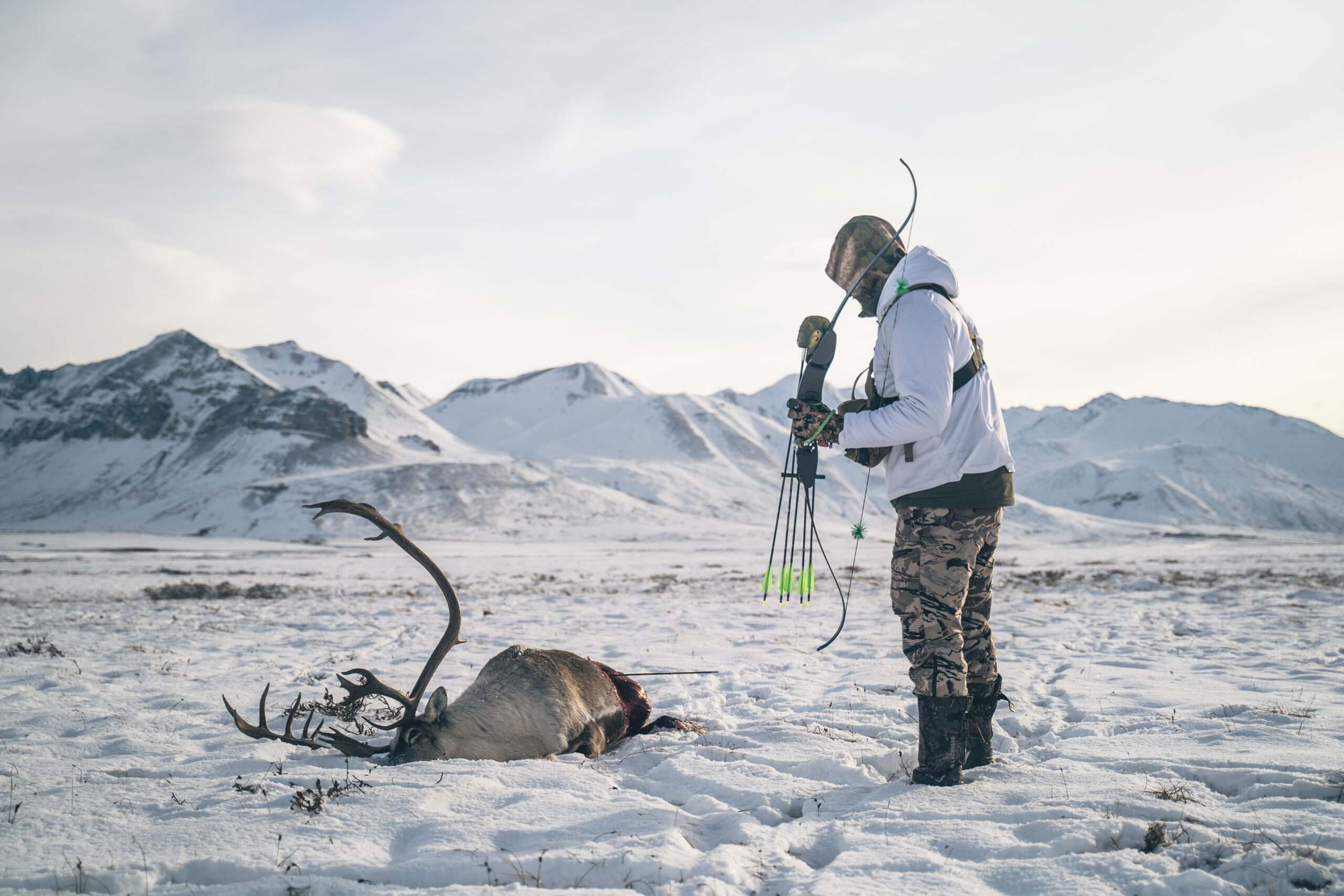
As the caribou flowed across the road, we quickly turned around, parked the truck, and began walking down the creek to intercept them. They were crossing the gulley in a shallow, flat spot, several hundred yards from the edge of any brush. We managed to slip into a sizeable gap in the herd and were frantically trying to find a position to hide and wait, when my dad (who was kneeling right next to me) whispered, “There’s antlers right there, about 30 yards!”
If there’s one thing that’s a dead giveaway that a bull caribou is coming, it’s his set of tall antlers. If there’s any terrain between you, you’ll see his antlers long before he can see you.
If there’s one thing that’s a dead giveaway that a bull caribou is coming, it’s his set of tall antlers. If there’s any terrain between you, you’ll see his antlers long before he can see you. And at that moment, there were antlers sticking up above the small embankment—very close. We were in a bad spot though. I nocked an arrow, but Dad had to move away from me slightly. When he did that, the caribou spotted us and spooked, circling wide and crossing the shallow depression.
We cautiously stood and, not seeing any more caribou, tried to find a better position. Soon we spotted more antlers over a softly rolling rise in the tundra. Down on my knees, arrow nocked, I knew they were going to cross too far from us. In good conditions, 40 yards was pushing my reasonable limit with my recurve, but with a 20-mph wind, it was out of the question. One herd crossed at 75 yards, then another at 60, and then the herd fizzled out. After repositioning again and waiting, we decided to grab a cup of coffee and regroup. Each time we were getting closer, and we knew that something had to break our way sooner or later.
Before a much-needed lunch, I opted to drive back up to our vantage point and make sure nothing else was coming. Almost as soon as we got there, Dad and I saw yet another big herd. This group was on a trajectory that would take them near the line of tall brush that lined much of the creek, and we might have a place to hide. Again, we parked and hurried, walking through the brush as quickly as we could.
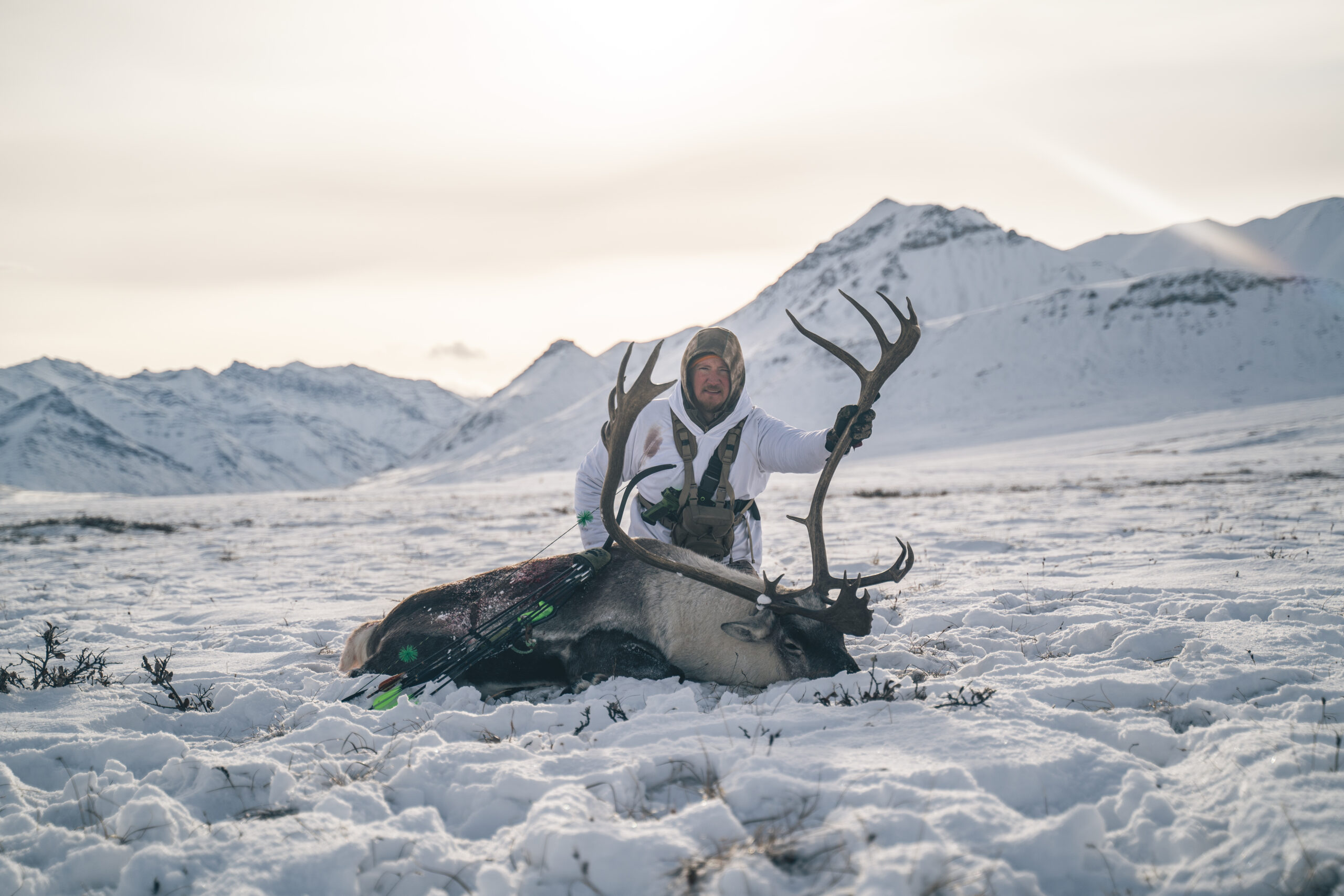
“We’re not going to make it in time,” I said, frustrated by our constant race against the clock.
I could see the backs of the caribou through the brush as they made their way across the open flat. They were just too fast, and we came to the end of the brush just as they started crossing the creek about 120 yards away.
“Why don’t you just try sneaking up there by yourself,” my dad said. “Three guys are too many, but one might be able to slip in there.”
It was worth a shot. Between us and the herd, the wash that the creek flowed through was about 3 to 4 feet deep, with a little bit of rolling terrain that might obscure the caribou that were coming. After a hundred or so had crossed, I began quickly, but carefully, moving down the draw. Eventually, some of the caribou that had already crossed began to see me, but kept on their way. I was still obscured from most of the animals that hadn’t yet crossed. I was skeptical about my chances, but after a small group saw me at about 60 yards, flared, and crossed farther down, a gap in the herd appeared. With antlers just coming into view, I quickly covered the remaining distance and dropped to my knees. I hid next to a small bush, arms-length from the main trail the herd had created. I watched the antlers, which looked to be following the group I had just bumped. There was nothing I could do but wait. I quickly ranged a rock in the cut bank across the winding trails in front of me. It was 30 yards away. I told myself I wouldn’t shoot at anything beyond that.
Seeing the rest of the herd safely across the creek must have calmed the caribou, because they quickly turned back toward me. All I could think as they closed the distance was: Don’t make eye contact.
Exposed, but holding absolutely still with my head tilted down, the cow that was leading the group came closer, followed by a nice bull. At under 10 yards I could hear her sniffing the air, even over the whipping wind. The bull was beyond her. As if I didn’t even exist, the cow walked past me, only paces away. My eyes shifted to the bull who was quartering to me, then to the rock I had ranged. He was only about 20-25 yards I figured, so I drew my bow.
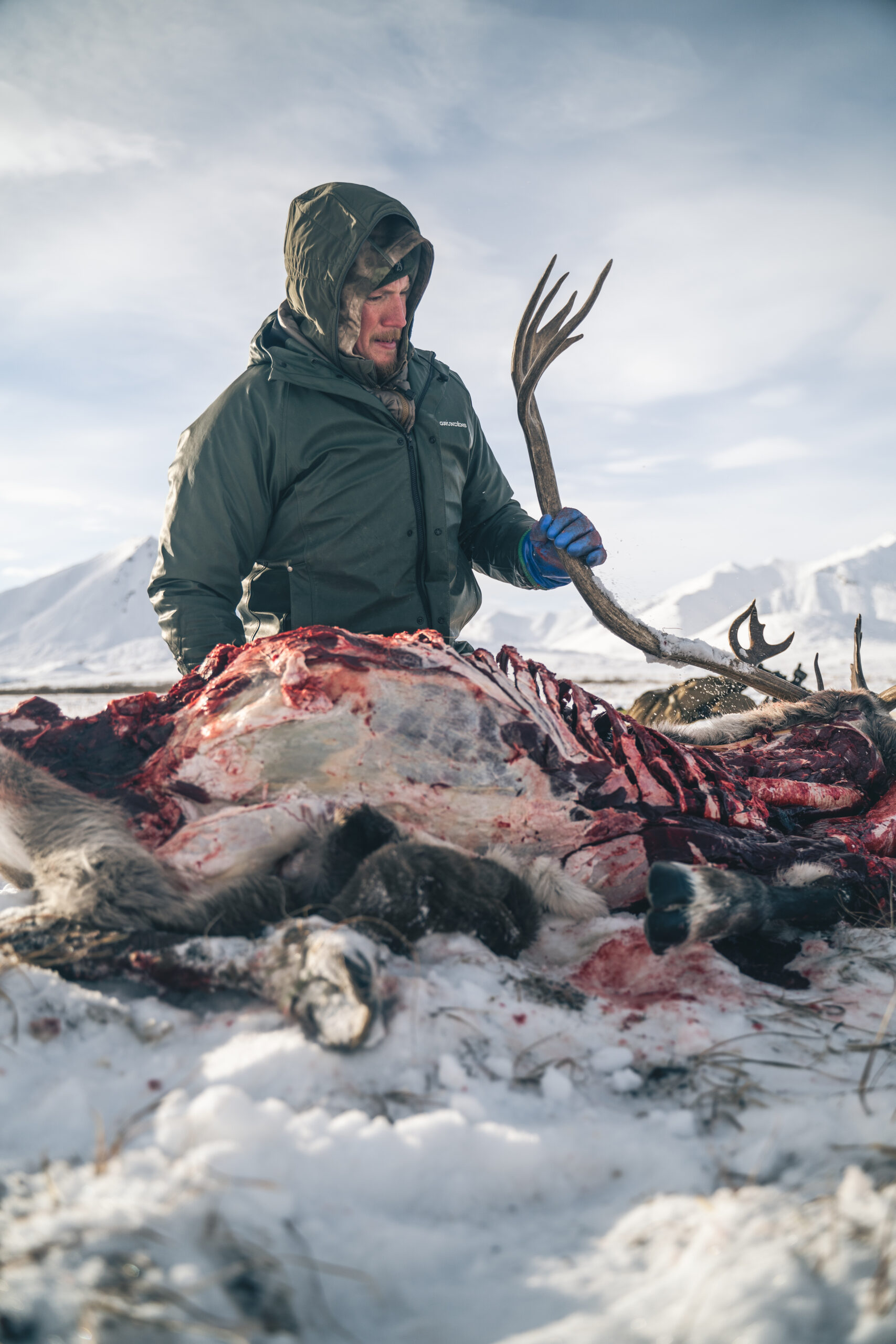
I was in a state of calm disbelief. Somehow I accepted that, aside from the timing and placement of my arrow, the situation was totally out of my control. I expected the bull to come out of his skin as soon as I moved, but he didn’t even notice me until I hit full draw. His head turned toward me at some point, but I only remember checking off my shot process. Anchor, good alignment, aim, expand—and the arrow disappeared into the bull. I wanted to hit him through the meat of the front shoulder to fully catch both lungs, but my arrow went a little high and left. The bull crossed the creek in a sprint then turned back. I stood to watch him as he ran about 150 yards back to meet the confused herd. The second the bull stopped running, another big bull ran up, hooked his antlers, and threw my bull on the ground, thrashing him as if my bull owed him money.
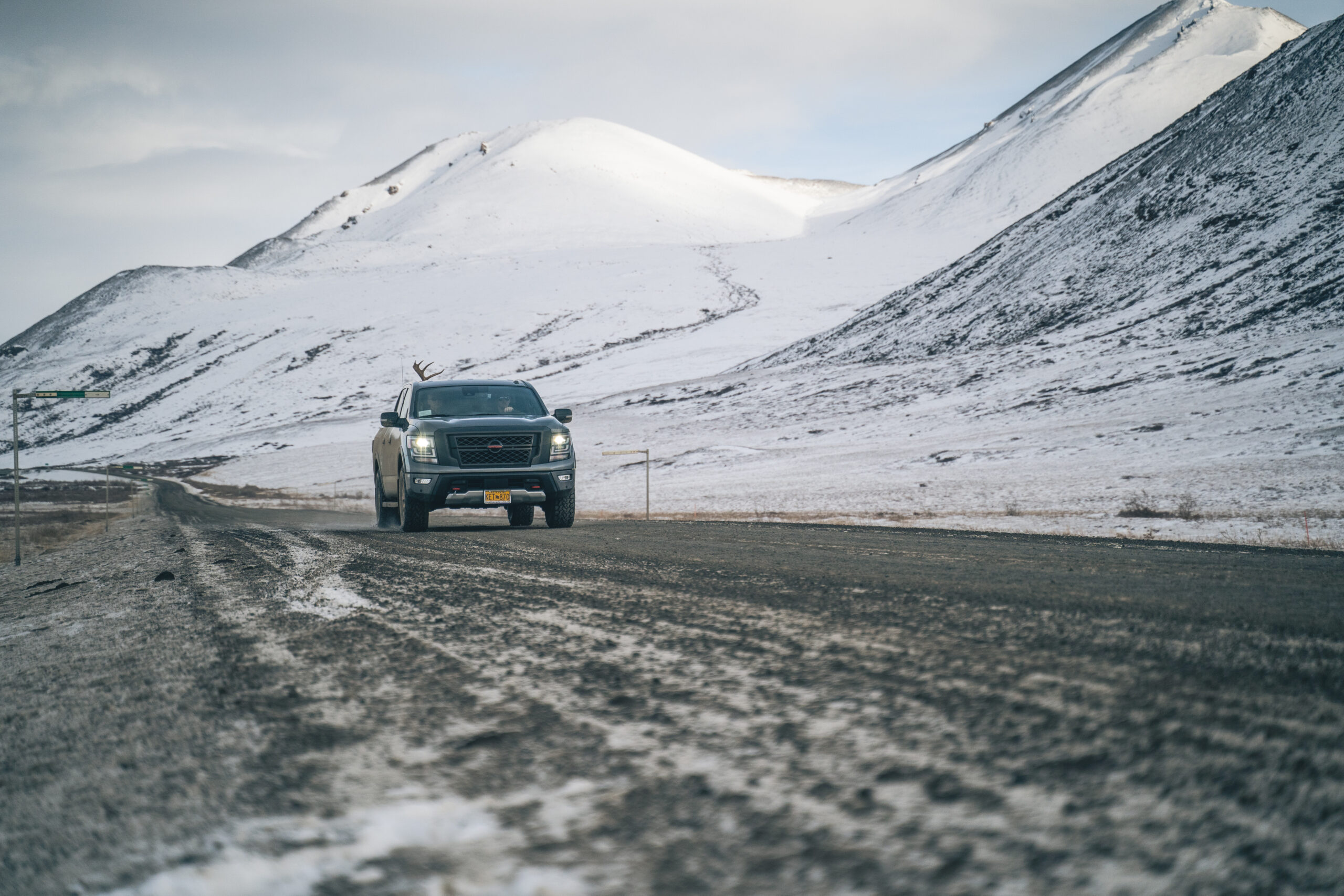
After the herd moved off, I walked up to my bull, still in disbelief. This beautiful white-caped bull at my feet was the true embodiment of the Arctic. As a hunter, I always experience a sense of thankfulness and relief when I can finally put my hands on an animal that I’ve hunted, and I felt that with this bull.
But more than the thankfulness for possession, of meat, hide, antlers, there was something that I haven’t experienced so strongly in a long time. It was a raw appreciation of that moment, that every hunter feels right when it works out. The feeling transcends space and time and connects the hunter to the feeling of the arrow being released. That experience is a true gift that will last long after all the meat is gone.
